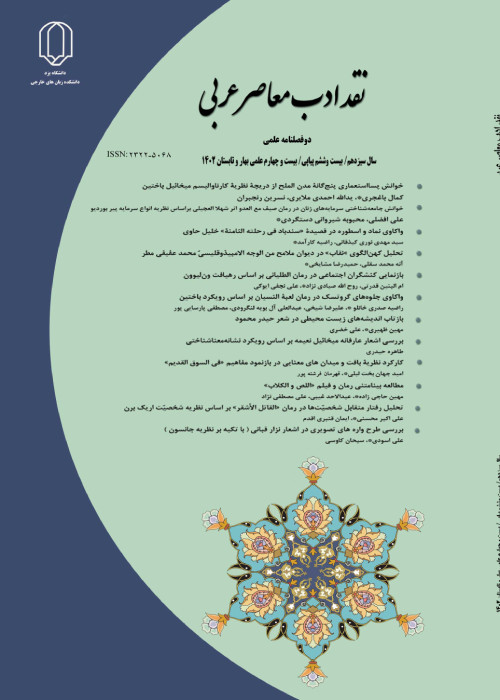A Study of Cohesion in the Syntactic Structure of Poetry of Resistance: A Case Study of Bseiso, al-Fitoori, and al-Saegh’s Poems
Author(s):
Article Type:
Case Study (دارای رتبه معتبر)
Abstract:
Introduction
The cohesion of poetic elements is one of the factors contributing to the organic unity of odes. Poetic cohesion is the result of various elements, especially coordinating conjunctions. In other words, the literariness of a text is the result of syntactic coordination. Since the early 20th century and with the advent of modernist literary movements in the Arab world, the subject of cohesion and coherence in odes has turned into a hot topic. In this regard, the structure of modern poetry is set free from the strict systematism of traditional poems, which was held by the poets of the 1950s as an important element of poetry. In other words, since a poetic context is made up of various phonetic, syntactic, rhetorical, and semantic structures, it is of necessity to find a way to connect these distinct structures. In other words, these structures are so distinct that, in order to capture the nuances involved in each area, each has turned into a distinct field of study. Therefore, the present study focuses on coordinating conjunctions, which are related to the syntactic layer. Furthermore, the existing cohesion is studied in larger linguistic units, i.e., sentences, and the type and usage of these links are analyzed by considering coordinating conjunctions and syntactic parallelism, structures lacking coordinating conjunctions and cause-and-effect relations. To this end, twenty odes by three resistance poets (Muin Bseiso, Muhammad al- Fitoori, and Adnan al-Saegh) are studied to answer the research questions a) What is the relationship between the context and the poetic components of the selected poems? and b) What are the most important elements in achieving syntactic cohesion in the works of these three poets?Methodology
The present research is a descriptive-analytical-comparative one. It seeks to study the syntactic cohesion and its types in twenty odes written by Bseiso, al- Fitoori, and al-Saegh.Results and Discussion
Unlike Bseiso’s poems, referral compounds in al-Fitoori’s poems are used frequently. Such structures are tangible and undeniable ones which originate from the stagnation, dictatorship and colonialism existing in the society. The poem, consequently, shows this feeling and approach perfectly well by making use of coordinating conjunctions to link different sentences in the poem. This feature is indicative of the stagnation and dullness and removes the liveliness and speed of the words. On the other hand, Bseiso has combative and fierce spirits, and he rushes to oust the enemies and urges people to show up in battlefields. This makes his poems devoid of referral compounds. Al-Saegh’s poems are structurally different and arranged in a pleasing manner and, therefore, enjoy a high level of cohesion. Each sentence can be considered as a macro-structure in which several sentences are embedded and each macro-structure is repeated in the next structure with exactly the same coordination; the ode of ‘Maqate’’ can be a case in point. Unlike the other two poets, al-Fitoori makes extensive use of ‘uslub al-shart’ (conditionals) to express his and his people’s degree of resistance. This structure, in addition to coordination and musicality, sheds light on the poet’s thought in terms of meaning.Conclusion
Studying the poems written by the poets of resistance yields the following conclusions
a). Al-Fitoori has made use of coordination to link his sentences where a mystical feeling was dominant and no conjunctions were used. This is as if there is a feeling of divine intoxication and surprise to link the sentences together with no need for coordinating conjunctions.b) Bseiso’s poetry, compared to al-Fitoori’s, makes use of these elements much less frequently in connecting the sentences. Bseiso’s wrath and belligerence have caused him to write sentence without any kind of link. In other words, his rush for ousting the enemies and encouraging people is a factor that has led to this feature in his poetry.
c) Al-Saegh’s poetry makes use of repetitive coordinations to link the sentences semantically and contextually. The different structure of his poem resembles more that of prose, and semantic relations are observed quite frequently. Furthermore, unlike Bseiso and al-Saegh, al-Fitoori makes extensive use of conditionals and the poet, quite vividly, depicts the toleration of torture, pain, and difficulty on the way to liberate one’s home country and ousting foreign colonialists. Furthermore, through cause-and-effect relationships, he actually warns his enemies against his seriousness and irreconcilability. However, such a cause-and-effect relationship can be achieved through a literary and emotional look which makes the audience ponder and delve into the details.
Keywords:
Language:
Persian
Published:
نشریه نقد ادب معاصر عربی, Volume:12 Issue: 22, 2022
Pages:
165 to 183
magiran.com/p2491253
دانلود و مطالعه متن این مقاله با یکی از روشهای زیر امکان پذیر است:
اشتراک شخصی
با عضویت و پرداخت آنلاین حق اشتراک یکساله به مبلغ 1,390,000ريال میتوانید 70 عنوان مطلب دانلود کنید!
اشتراک سازمانی
به کتابخانه دانشگاه یا محل کار خود پیشنهاد کنید تا اشتراک سازمانی این پایگاه را برای دسترسی نامحدود همه کاربران به متن مطالب تهیه نمایند!
توجه!
- حق عضویت دریافتی صرف حمایت از نشریات عضو و نگهداری، تکمیل و توسعه مگیران میشود.
- پرداخت حق اشتراک و دانلود مقالات اجازه بازنشر آن در سایر رسانههای چاپی و دیجیتال را به کاربر نمیدهد.
In order to view content subscription is required
Personal subscription
Subscribe magiran.com for 70 € euros via PayPal and download 70 articles during a year.
Organization subscription
Please contact us to subscribe your university or library for unlimited access!



